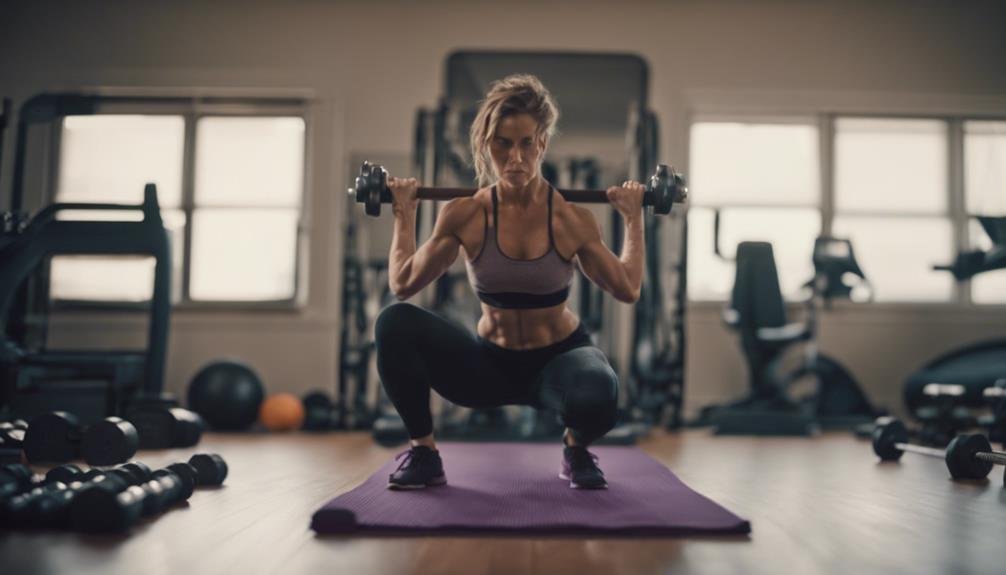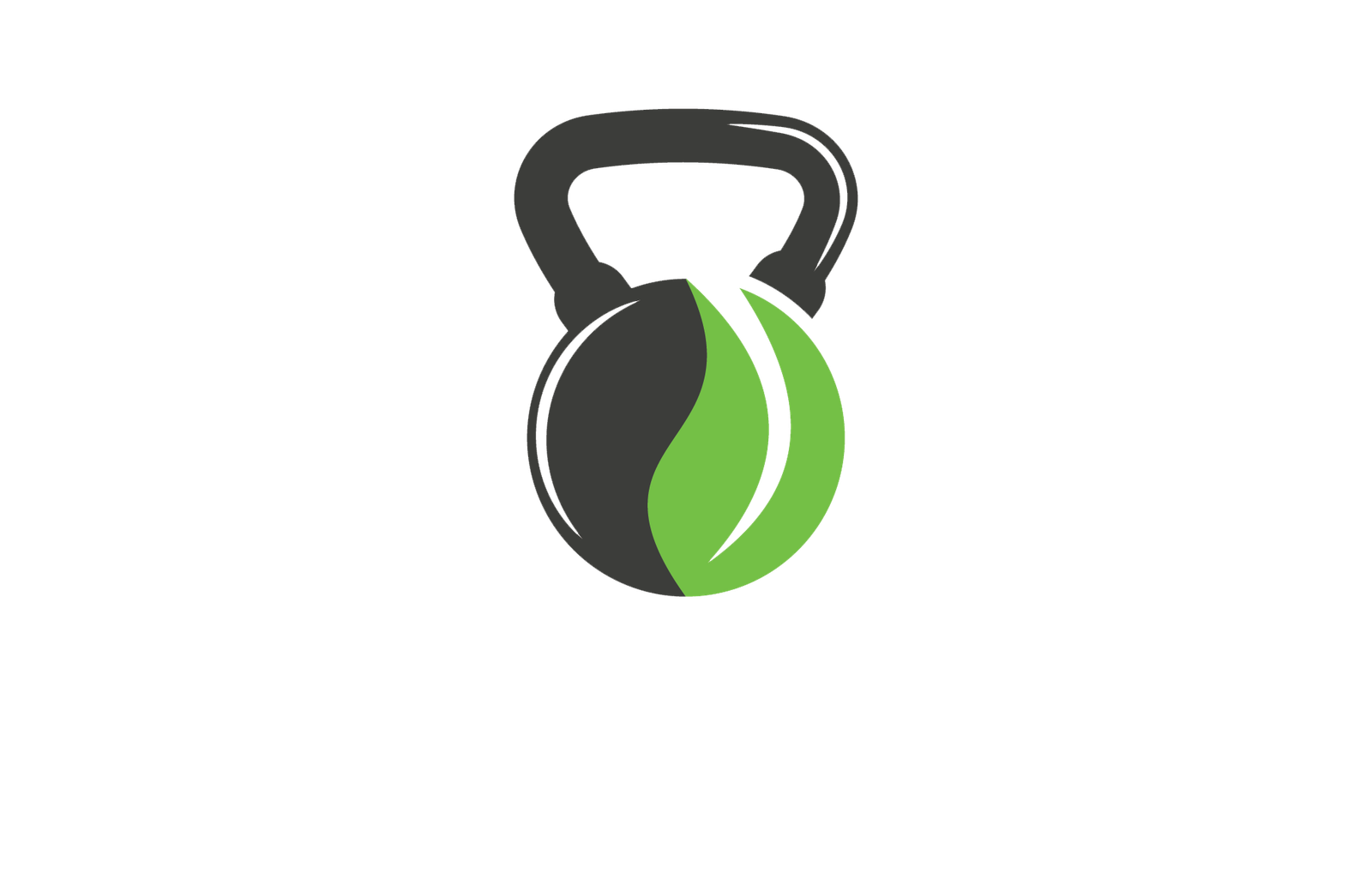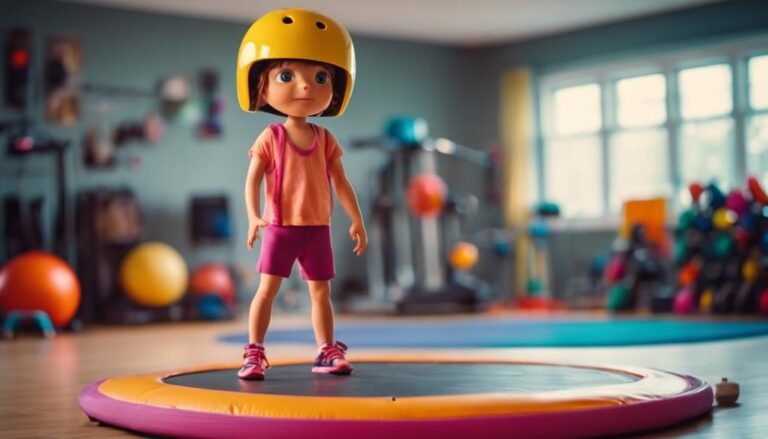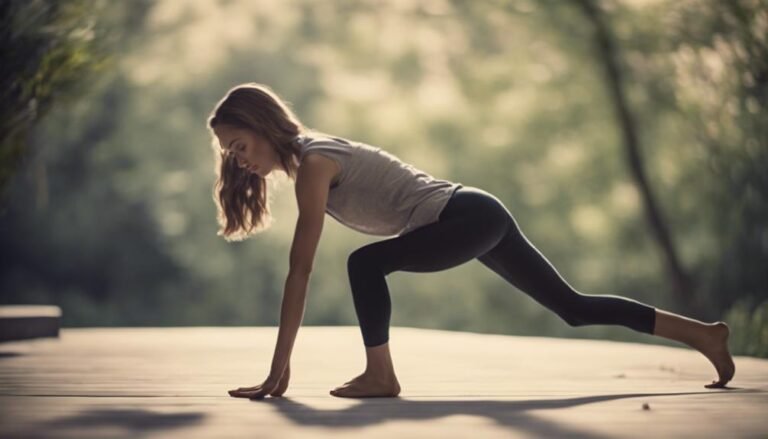Don't miss our holiday offer - 20% OFF!

Best Upper Body Workouts for Home Fitness
Achieve a strong and toned upper body at home with these effective workouts, and discover the secrets to taking your fitness to the next level.
We're taking control of our upper body fitness at home by leveraging the power of bodyweight exercises, strategic equipment choices, and a clear understanding of the most effective exercises and routines to achieve strength, stability, and overall wellness. With a focus on mindful movement and progressive overload, we're building strength and mastering exercises like push-ups, tricep dips, and rows. We're also incorporating essential equipment like dumbbells and resistance systems to enhance our workouts. By understanding the fundamentals of upper body exercises, we're creating a balanced routine that targets all major muscle groups, and we're excited to dive deeper into the specifics of each exercise to take our fitness to the next level!
Key Takeaways
- Master bodyweight exercises like push-ups, tricep dips, and rows to target multiple upper body muscle groups at home.
- Invest in essential home workout equipment like dumbbells, adjustable resistance systems, and compact pulley machines for a well-rounded routine.
- Focus on proper form, engagement of core muscles, and controlled movements to prevent injury and promote effective exercise.
- Incorporate exercises that target different muscle groups, such as chest, back, shoulders, triceps, and biceps, for a balanced upper body workout.
- Gradually increase difficulty, reps, or sets over time to achieve progressive overload and continued strength gains at home.
Building Strength With Bodyweight Exercises
We can build significant strength without relying on cumbersome equipment or expensive gym memberships by harnessing the power of bodyweight exercises. By incorporating bodyweight exercises into our workout routine, we can focus on mindful movement and progressive overload to achieve impressive gains. Progressive overload, the gradual increase in weight or resistance, is key to building strength, and with bodyweight exercises, we can achieve this by increasing the difficulty of movements or adding more reps and sets.
As we master each exercise, we can modify it to make it more challenging, guaranteeing continued progress. Mindful movement is also essential, as it allows us to engage our core, maintain proper form, and target the intended muscle groups. By focusing on slow, controlled movements, we can confirm that we're working the right muscles and avoiding injury. With bodyweight exercises, the possibilities are endless, and we can create a thorough upper body workout that targets our chest, back, shoulders, and arms. By committing to a regular bodyweight exercise routine, we can achieve significant strength gains and a more toned upper body.
Essential Upper Body Equipment for Home
As we take our upper body workouts to the next level, we're going to need the right equipment to support our progress. We'll start by investing in a few essential pieces that'll help us target our muscles from different angles, including dumbbells for our home gym, adjustable resistance systems, and compact pulley machines. With these tools, we'll be able to challenge ourselves and see real results in our strength and physique.
Dumbbells for Home Gym
Building a home gym without dumbbells is like trying to build a strong upper body without exercises – it's just not happening. We can't stress enough how essential dumbbells are for a well-rounded upper body workout. They're versatile, space-efficient, and allow for a wide range of exercises that target multiple muscle groups. When it comes to dumbbell storage, we recommend investing in a compact rack or stand that can hold multiple pairs of dumbbells. This will keep your workout space organized and clutter-free, allowing you to focus on your fitness goals. Speaking of workout space, dumbbells are perfect for small home gyms or apartments with limited space. They're easy to store and can be used in a variety of exercises, from bicep curls to shoulder presses. With dumbbells, we can work out from the comfort of our own homes, without having to sacrifice effectiveness or results. So, if you're serious about building a strong upper body, make sure to include dumbbells in your home gym setup.
Adjustable Resistance Systems
With adjustable resistance systems, we're able to tackle a wide range of upper body exercises with precision and control, allowing us to target specific muscle groups and achieve a more thorough workout. These systems typically include cable machines and resistance bands, which provide a smooth and consistent resistance that helps to build strength and endurance. We love that adjustable resistance systems allow us to customize our workout to our fitness level, making them perfect for both beginners and seasoned athletes. Plus, they're often compact and space-saving, making them a great addition to our home gym. With adjustable resistance systems, we can perform a variety of exercises, including rows, chest presses, and shoulder rotations. They're also great for targeting smaller muscle groups, like our rotator cuffs and shoulder blades. By incorporating adjustable resistance systems into our workout routine, we can take our upper body training to the next level and achieve the results we've always wanted.
Compact Pulley Machines
We opt for compact pulley machines as essential upper body equipment for our home gym because they provide an unparalleled level of versatility and space-saving efficiency. As space savers, these machines are perfect for our home gyms, allowing us to maximize our workout space without compromising on the exercises we can do. With compact pulley machines, we can target multiple muscle groups, including our chest, back, shoulders, and arms, making them an excellent addition to our home gym.
Here are just a few reasons why we love compact pulley machines:
- Space efficiency: They take up minimal space, making them perfect for small home gyms.
- Versatility: We can perform a wide range of exercises, from chest presses to rows and shoulder presses.
- Adjustable resistance: We can easily adjust the resistance level to suit our fitness goals.
- Cost-effective: Compact pulley machines are often more affordable than other types of gym equipment.
Push-Up Variations for Beginners
As we start our push-up journey, we're excited to explore variations that'll help us build strength and confidence. We'll begin with modified push-ups, perfect for those who need a more accessible entry point, and then master the basic push-up form that's essential for progressing to more advanced exercises. By focusing on these foundational movements, we'll set ourselves up for success and create a strong upper body workout routine.
Modified Push-Ups
Let's kick off our upper body workout journey with modified push-ups, a fantastic alternative for beginners who struggle to perform traditional push-ups. These variations are designed to make the exercise more accessible, allowing us to build strength and confidence before progressing to more challenging versions.
When performing modified push-ups, proper form and engagement are crucial. Here are some key points to keep in mind:
- Knee placement: Instead of using our toes, we'll place our knees on the ground, reducing the amount of weight we need to lift.
- Core engagement: Engage our core muscles to maintain a straight line from head to knees, ensuring we don't let our hips sag or our backs arch.
- We'll keep our hands shoulder-width apart, with our fingers facing forward or slightly inward.
- As we lower ourselves, we'll focus on slow and controlled movements, avoiding any jerky motions.
Basic Push-Up Form
With our modified push-ups under our belt, we're now ready to tackle the basic push-up form, a foundational exercise that targets multiple upper body muscle groups and sets the stage for more advanced variations. This classic exercise is a staple in any workout routine, and for good reason – it effectively engages our chest, shoulders, and triceps while strengthening our core.
To master the basic push-up form, we need to focus on proper alignment. Start by placing our hands shoulder-width apart, with our fingers facing forward or slightly inward. Our feet should be hip-width apart, with our weight evenly distributed between our hands and toes. Engage our core muscles by drawing our belly button towards our spine, keeping our body in a straight line from head to heels.
As we lower ourselves down, keep our elbows close to our body, avoiding letting them flare out to the sides. Push back up to the starting position, squeezing our chest muscles at the top. Remember to breathe naturally, inhaling on the way down and exhaling on the way up. With consistent practice, we'll build strength, endurance, and confidence to take on more challenging push-up variations.
Effective Tricep Exercises at Home
We can effectively target our triceps from the comfort of our own homes with a few simple, yet intense exercises that require minimal equipment. With a little creativity and dedication, we can achieve tricep toning and strengthen our upper body without stepping foot in a gym.
To get started, let's focus on four essential exercises that will help us achieve maximum tricep development:
- Tricep Dips: Using a chair or bench, we can perform tricep dips that target the back of our upper arm.
- Overhead Tricep Extensions: With a dumbbell or water bottle, we can perform overhead extensions that engage our triceps.
- Close-Grip Push-Ups: Modifying traditional push-ups with a close grip targets our triceps and provides an intense workout.
- Tricep Stretches: Don't forget to stretch our triceps after a workout to prevent injury and promote recovery.
Rowing Exercises for Back Strength
As we focus on rowing exercises for back strength, we're excited to explore the essential components that will take our workout to the next level. We'll start by mastering the rowing motion basics, which will help us understand the proper form and technique. From there, we'll discover the muscle groups targeted by these exercises and explore the various exercise variations that will keep our workouts fresh and challenging.
Rowing Motion Basics
When we grip the bar with our hands shoulder-width apart, we're not just preparing for a casual row – we're setting ourselves up to target the latissimus dorsi, those powerful muscles that run from our armpits to our lower back. This is where rowing techniques come into play, and mastering the basics is essential for effective muscle activation.
To get the most out of our rowing exercises, we need to focus on proper form and technique. Here are some key takeaways to keep in mind:
- Keep our core engaged: This will help us maintain a straight back and generate power from our core muscles.
- Squeeze our lats: Focus on squeezing our latissimus dorsi muscles as we pull the bar towards our chest.
- Use our legs: Drive through our heels to generate power and momentum.
- Control the movement: Take our time and control the movement as we lower the bar back down to the starting position.
Muscle Groups Targeted
By incorporating rowing exercises into our workout routine, we're not only targeting our latissimus dorsi, but also engaging multiple muscle groups that contribute to overall back strength. This all-encompassing engagement is what makes rowing exercises so effective for building a strong, toned back. As we perform a Lat Pull, we're engaging our trapezius, rhomboids, and erector spinae, which work together to maintain proper posture and stability. Additionally, rowing exercises also contribute to pectoral development, as our chest muscles help to control the movement of our arms and shoulders. By targeting these muscle groups simultaneously, we're able to achieve a more balanced and efficient workout. In addition, rowing exercises also engage our core muscles, which are essential for maintaining stability and preventing injury. By incorporating rowing exercises into our workout routine, we're not only building strength and endurance, but also improving our overall posture and reducing our risk of injury.
Exercise Variations
Let's plunge into the world of rowing exercises, where we can mix and match variations to keep our workouts fresh and challenging, while continuously targeting our back muscles from different angles. We've got a plethora of exercise options to choose from, and the best part is that we can swap them out to avoid plateaus and prevent boredom.
Here are some of our favorite rowing exercise variations:
- Bent-over rows: Works the latissimus dorsi, rhomboids, and trapezius muscles.
- Seated rows: Targets the latissimus dorsi, rhomboids, and biceps.
- Rowing machine exercises: Engages the entire back, including the latissimus dorsi, trapezius, and rhomboids.
- Inverted rows: Focuses on the latissimus dorsi, biceps, and upper back muscles.
Simple Shoulder Presses for Beginners
We're tackling simple shoulder presses, a foundational exercise that targets the deltoids and helps build overall upper body strength and stability. As beginners, you must understand the basics of shoulder anatomy to get the most out of this exercise. The deltoids, comprising the anterior, medial, and posterior heads, work together to control arm movements. When performing a shoulder press, we're engaging these muscles to lift the weight overhead.
Now, let's focus on pressing form. Stand with your feet shoulder-width apart, holding dumbbells or a barbell at shoulder height. Engage your core, squeeze your shoulder blades together, and press the weight straight up over your head. Avoid arching your back or using momentum, as this can put unnecessary strain on your joints. Instead, focus on slow and controlled movements, taking 2-3 seconds to lift and 2-3 seconds to lower. Start with lighter weights and gradually increase the load as you build strength and confidence. With consistent practice and proper form, we can develop strong, toned shoulders that will elevate our overall fitness level.
Home Workout Routines for Bigger Biceps
Building bigger biceps at home requires a combination of consistent training, proper form, and a well-structured routine that targets the biceps from different angles. It can be tough to stay motivated, but trust us, the results are worth it! Understanding bicep anatomy is key to designing an effective workout routine. The biceps brachii, a two-headed muscle, is responsible for bending the elbow and forearm. To effectively target this muscle, we need to incorporate exercises that work both the short and long heads.
Four essential tips to keep in mind when creating your home workout routine for bigger biceps:
- Start with proper form: Make sure to keep your upper arms still and only move your forearms during exercises.
- Incorporate variation: Mix up your routine with exercises like bicep curls, hammer curls, and preacher curls to target the biceps from different angles.
- Use progressive overload: Gradually increase the weight or resistance to challenge your biceps and stimulate growth.
- Stay consistent: Aim to train your biceps 2-3 times a week, with at least a day of rest in between, to allow for proper recovery and growth.
It's undeniable that staying motivated can be tough, but the results are worth it!
Chest Exercises Without Weights
We can work our chest muscles just as effectively without weights, and it's time to explore exercises that target the pectoralis major without relying on heavy lifting. Bodyweight exercises can be just as challenging and effective as weightlifting, and they're perfect for those days when we don't have access to equipment or prefer a low-impact workout. Let's focus on exercises that engage our chest muscles, like push-ups, chest dips, and pec flys. These exercises will help improve our pec development and overall chest strength. Additionally, incorporating chest stretching exercises into our routine can increase flexibility and range of motion. By incorporating these exercises into our workout routine, we'll be on our way to stronger, more toned chests. Remember to start slow, focus on proper form, and gradually increase the difficulty as we get stronger. With consistency and patience, we can achieve impressive results without ever lifting a weight. So, let's get started and take our chest workout to the next level!
Back Exercises for Improved Posture
By incorporating targeted exercises into our routine, we can substantially improve our posture, reducing the likelihood of back pain and boosting our overall confidence. As we focus on strengthening our back muscles, we'll notice a significant improvement in our overall spinal alignment. This, in turn, will enhance our overall physical appearance and reduce the risk of injuries.
To achieve peak results, we need to engage our core muscles. Four essential exercises to include in our routine are:
- Lat Pulldowns: Targets the latissimus dorsi muscles, helping to pull our shoulders back and improve posture.
- Row Exercises: Strengthens the trapezius and rhomboid muscles, enhancing spinal alignment and reducing the risk of back pain.
- Superman Pose: Engages the erector spinae muscles, promoting a strong and confident posture.
- Bird Dog: Targets the entire back, improving flexibility and reducing muscle tension.
Creating a Balanced Upper Body Routine
As we shift our focus to crafting a well-rounded upper body workout, it's essential that we distribute our attention evenly across the chest, back, and shoulders to avoid muscle imbalances and promote overall upper body strength. By doing so, we'll achieve Upper Body Harmony, where each muscle group works in tandem to enhance our overall fitness.
To create a balanced routine, we'll want to allocate our workout time wisely. Aim to dedicate 30-40% of our upper body workout to chest exercises, 30-40% to back exercises, and 20-30% to shoulder exercises. This distribution will ensure we're building strength and stability across all major muscle groups.
As we work towards Upper Body Harmony, it's crucial to set specific, measurable Fitness Goals. Are we looking to increase our bench press max? Improve our posture? Enhance overall muscle tone? By defining our goals, we'll stay motivated and focused, driving us to push ourselves harder and achieve the results we desire. By committing to a balanced upper body routine, we'll unlock our full fitness potential and reap the rewards of a stronger, more confident us.
Tips for Avoiding Injury at Home
To prevent setbacks and guarantee a safe, effective workout at home, to take proactive measures that safeguard our bodies against injury is crucial. We've all been there – we get excited to start a new workout routine, only to find ourselves sidelined by an avoidable injury. Don't let that be us! By taking a few simple precautions, we can ensure a safe and successful workout experience.
Here are some essential tips to keep in mind:
- Warm up and cool down: Proper stretching is key to preventing muscle strain and injury. Make sure to warm up before your workout and cool down afterwards to prevent sudden changes in your heart rate and muscle tension.
- Choose safe flooring: Avoid working out on hard or slippery surfaces that can cause falls or discomfort. Opt for a yoga mat or a soft, non-slip surface instead.
- Listen to our bodies: If we're feeling tired or experiencing pain, it's okay to take a break or stop altogether. Our bodies are sending us signals – let's listen to them!
- Start slow and progress gradually: Don't try to do too much too soon. Gradually increase the intensity and difficulty of our workouts to avoid burnout and injury.
Frequently Asked Questions
Can I Do Upper Body Workouts With a Shoulder Injury?
We understand the concern: can we still do upper body workouts with a shoulder injury? Yes, we can, but it's essential to prioritize injury prevention and modify exercises to accommodate our limitations, ensuring a safe and effective workout.
Will Home Workouts Replace My Gym Membership?
We're ditching gym intimidation and opting for home workouts as a viable membership alternative, and honestly, we're loving the convenience and flexibility – our fitness journey has never felt more empowered!
How Long Will It Take to See Results From Home Workouts?
'We're all keen to see results, but understand that consistency matters – patience is vital to be patient with our workout routine. With dedication, we'll start noticing changes in 4-6 weeks, and significant progress in 3-6 months, so let's stay committed and celebrate our progress!'
Are Bodyweight Exercises as Effective as Weightlifting?
"Did you know 70% of gym-goers skip leg day? We've found bodyweight exercises can be just as effective as weightlifting, as long as we avoid muscle imbalances and incorporate progressive overload to challenge ourselves."
Can I Customize Workouts to Fit My Fitness Level?
"We totally can customize workouts to fit our fitness level! By setting specific fitness goals, we tailor our workout routines to our needs, ensuring progressive overload and continuous progress, regardless of our current fitness level."
Conclusion
As we flex our fitness muscles, we've forged a formidable foundation for a strong upper body. We've pushed past plateaus, pumped up our pecs, and perfected our posture. Now, it's time to propel ourselves forward, precision-crafting a personalized workout plan that pivots around our passions and priorities. By combining these carefully curated exercises, we'll be sculpting a stunning silhouette in no time – and proudly proclaiming our prowess in the process.



